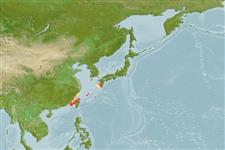Environment: milieu / climate zone / depth range / distribution range
นิเวศวิทยา
เกี่ยวกับทะเล,น้ำเค็ม; ระดับความลึก 0 - ? m. Subtropical; 32°N - 23°N
Northwest Pacific: southern Japan and Taiwan (Ref. 5193). Not in Russia as in (Ref. 27863) (Parin, pers. comm.).
ขนาด / น้ำหนัก / Age
Maturity: Lm ? range ? - ? cm
Max length : 35.0 cm SL เพศผู้/กระเทย; (Ref. 559)
Found in the neritic zone (Ref. 11230). Spawning school captured with gill-net in early summer. Common and commercially valued. Used in Chinese medicine (Ref. 12166).
Life cycle and mating behavior
วัยเจริญพันธุ์ | การสืบพันธุ์ | การวางไข่ | เซลสืบพันธ์ของเพศเมีย(ไข่) | ความดกของไข่ | ตัวอ่อน
Masuda, H., K. Amaoka, C. Araga, T. Uyeno and T. Yoshino, 1984. The fishes of the Japanese Archipelago. Vol. 1. Tokai University Press, Tokyo, Japan. 437 p. (text). (Ref. 559)
IUCN Red List Status (Ref. 130435: Version 2024-1)
Threat to humans
Harmless
Human uses
การประมง: การค้า
เครื่องมือ
Special reports
Download XML
แหล่งที่มาจากอินเตอร์เน็ต
Estimates based on models
Preferred temperature (Ref.
123201): 21.4 - 26.1, mean 24.5 °C (based on 123 cells).
Phylogenetic diversity index (Ref.
82804): PD
50 = 0.5000 [Uniqueness, from 0.5 = low to 2.0 = high].
Bayesian length-weight: a=0.00631 (0.00288 - 0.01384), b=3.05 (2.85 - 3.25), in cm total length, based on LWR estimates for this (Sub)family-body shape (Ref.
93245).
ระดับชั้นอาหาร (Ref.
69278): 3.4 ±0.45 se; based on food items.
ความสามารถในการกลับคืนสู่ปกติ (Ref.
120179): ความสูง, เวลาต่ำสุดที่จะทำให้ประชากรเพิ่มขึ้นเป็น 2 เท่าใช้เวลาน้อยกว่า 15 เดือน (Assuming tm=1).
Fishing Vulnerability (Ref.
59153): Low to moderate vulnerability (33 of 100).
Climate Vulnerability (Ref.
125649): Very high vulnerability (88 of 100).
Nutrients (Ref.
124155): Calcium = 228 [83, 455] mg/100g; Iron = 1.76 [0.90, 3.98] mg/100g; Protein = 17.7 [15.6, 19.6] %; Omega3 = 0.319 [0.147, 0.878] g/100g; Selenium = 20.2 [8.9, 42.9] μg/100g; VitaminA = 18.2 [5.5, 69.8] μg/100g; Zinc = 0.891 [0.607, 1.352] mg/100g (wet weight);
